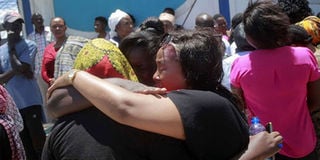'You are on your own in case of tragedy': KFS

Friends and relatives of the mother and child who drowned after their vehicle fell into the Indian Ocean at the Likoni ferry channel on September 30, 2019 console each other. The Kenya Ferry Services is ill-equipped to tackle emergency situations. PHOTO | LABAN WALLOGA | NATION MEDIA GROUP
What you need to know:
- KFS Managing Director Bakari Gowa said that the parastatal does not have an emergency team of divers or lifeguards.
- Also deplorable is that there is no video footage of what happened, as the ferry lacks a closed-circuit television camera, a requirement for modern vessels.
It is the busiest ferry crossing in the country, connecting more than 360,000 residents daily.
Some two million vehicles move from Mombasa island and Likoni mainland every year.
Unfortunately, you are on your own should anything happen to you at the channel, one of the deepest natural canals in the world. Expect no help as you sink into the 80-metre depth of death.
It’s a shameful reality that Coast residents must live with, even as the millions of shillings invested in Kenya Ferry Services cannot afford them decent rescue plans.
At 6.15pm on Sunday, 35-year-old Mariam Kighenda and her four-year-old daughter Amanda Mutheu drowned when their car, which was on MV Harambee ferry, fell into the Indian Ocean. Mutheu was a pupil at MM Shah Academy.
Amid cries for help from Kighenda, nothing came forth as her car was swallowed by the ocean waters.
“I saw the woman and child inside the car. She called for help when it started to reverse. I threw a life saver at them,” Mr Mlei Majaliwa, a ferry passenger, said.
EMERGENCY TEAM
The vessel pushed on, with onlookers screaming their lungs out. There were no divers or emergency teams on the ferry at the time of the incident.
As part of its safety features, KFS says it can only provide fire-fighting equipment and on-board guards.
KFS Managing Director Bakari Gowa told the Nation that the parastatal does not have an emergency team of divers or lifeguards, only relying on the Kenya Ports Authority, local divers and the navy.
“Our capacity is for cases of people, not vehicles. To have an emergency rescue team is not a small investment,” Mr Gowa said.
Ordinarily, divers are for recovery missions, while lifeguards are expert swimmers employed to rescue people in case of difficulties at sea.
Asked how long it would take KPA and the navy to respond to an emergency, Mr Gowa said it “does not go beyond 20 minutes”.
REMUNERATION
The KFS has four speed boats, with only one operational in case of an emergency.
Two of the boats were launched recently following procurement of MV Jambo in August 2017.
Mr Musa Sila, a local diver, said he and his colleagues have been neglected by KFS. “I’ve never been paid despite being involved in many rescue operations. No one has considered employing us to save lives at the channel.”
Residents raised several questions after the Sunday evening tragedy. Why doesn’t KFS have working emergency teams on its vessels and ashore?
Why was the ferry ramp lowered? Why are passengers and drivers allowed to sit in their vehicles contrary to standard procedure?
Why doesn’t KFS have standby emergency speed boats and active divers?
NO CCTV
The incident is troubling for an agency whose core business is to cross people, vehicle and goods, safely on the channel. How does it run its business without the necessary gadgets to reach to the bottom in case of an emergency?
Also deplorable is that there is no video footage of what happened, as the ferry lacks a closed-circuit television camera, a requirement for modern vessels.
In June last year, KFS said it had awarded a Sh78 million contract to a company to instal security cameras on its vessels.
Sources at KFS said the vehicle was 60 metres deep yet the navy-owned oxygen tanks operate at a depth of 30 metres.
The state of MV Harambee, MV Kilindini and MV Nyayo, which have been in operation for almost 30 years, is horrid as the system operating their prows has been dysfunctional.
Normally, the prows should be at a 35 to 45 degree angle. But because of the defective state of the three ferries, their flaps are usually on water when the vessels are on the move.





